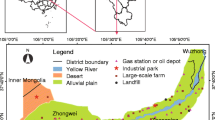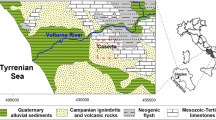Abstract
Many existing risk assessment methodologies heavily rely on complex physical models and probabilistic concepts, which are difficult to use and not suitable for a first-cut analysis. Meanwhile, most groundwater pollution risk assessment indices generally are solely based on groundwater vulnerability and ignore the consideration of the hazard of pollution source. In this paper, we developed a simple groundwater pollution risk index approach, which can be easily utilized in many developing countries. The approach is developed according to vulnerability of the aquifers and pollution source index, which is based on landfill treatment technology. Applications of this risk index approach to 22 formal landfill sites in Beijing show that 1, 2, 4, 10, 5 landfill sites can be classified as of high, medium high, medium, medium low, low risk level respectively. These results demonstrate that vulnerability assessment alone is not sufficient to groundwater pollution risk assessment. This simple risk assessment method is most suitable for a comparative assessment of a large number of pollution sources at a regional scale due to its lower cost and easy operability. It also allows prioritizes landfills for reclamation interventions and recommendation of required actions such that an efficient management of landfills could be accomplished.





Similar content being viewed by others
References
Al-Adamat RAN, Foster IDL, Baban SMJ (2003) Groundwater vulnerability and risk mapping for the Basaltic aquifer of the Azraq basin of Jordan using GIS, Remote sensing and DRASTIC. Appl Geogr 23:303–324. doi:10.1016/j.apgeog.2003.08.007
Aller L, Bennett T, Lehr JH, Petty RJ, Hackett G (1987) DRASTIC: a standardized system for evaluating groundwater pollution potential using hydrogeologics
Babiker IS, Mohamed MAA, Hiyama T, Kato K (2005) A GIS-based DRASTIC model for assessing aquifer vulnerability in Kakamigahara Heights, Gifu Prefecture, central Japan. Sci Total Environ 345:127–140. doi:10.1016/j.scitotenv.2004.11.005
Berkhoff K (2008) Spatially explicit groundwater vulnerability assessment to support the implementation of the Water Framework Directive - a practical approach with stakeholders. Hydrol Earth Syst Sci 12:111–122
Beven KJ, Smith PJ, Freer JE (2008) So just why would a modeller choose to be incoherent? J Hydrol 354:15–32. doi:10.1016/j.jhydrol.2008.02.007
Finizio A, Villa S (2002) Environmental risk assessment for pesticides: a tool for decision making. Environ Impact Assess Rev 22:235–248. doi:10.1016/S0195-9255(02)00002-1
Gogu RC, Dassargues A (2000) Current trends and future challenges in groundwater vulnerability assessment using overlay and index methods. Environ Geol 39:549–559
Huizhong J, Jianping L, Jie Z, Shuyun Z, Yiran D (2001) Modeling analysis of leachate pollution of sanitary fill on underground water in the Southern area of Beijing Western Suburb. World Geol 20:374–378. doi:10.3969/j.issn.1004-5589.2001.04.013
Ireland GSo (1999) Groundwater protection schemes
Laloy E, Vrugt JA (2012) High-dimensional posterior exploration of hydrologic models using multiple-try DREAM((ZS)) and high-performance computing. Water Resour Res 48 doi:10.1029/2011wr010608
Lan L (2008) Research on groundwater pollution and its prevention control policy in China. J China Univ Geosci (Social Sciences Edition)
Li Y, Li JH, Chen SS, Diao WH (2012) Establishing indices for groundwater contamination risk assessment in the vicinity of hazardous waste landfills in China. Environ Pollut 165:77–90. doi:10.1016/j.envpol.2011.12.042
Moratalla Á, Gómez-Alday J, Sanz D, Castaño S, De Las Heras J (2011) Evaluation of a GIS-based integrated vulnerability risk assessment for the Mancha Oriental System (SE Spain). Water Resour Manag 25:3677–3697. doi:10.1007/s11269-011-9876-0
Neukum C, Hotzl H (2007) Standardization of vulnerability maps. Environ Geol 51:689–694. doi:10.1007/s00254-006-0380-4
Rapti-Caputo D, Sdao F, Masi S (2006) Pollution risk assessment based on hydrogeological data and management of solid waste landfills. Eng Geol 85:122–131. doi:10.1016/j.enggeo.2005.09.033
Saidi S, Bouri S, Ben Dhia H, Anselme B (2009) A GIS-based susceptibility indexing method for irrigation and drinking water management planning: Application to Chebba-Mellouleche Aquifer, Tunisia. Agric Water Manag 96:1683–1690. doi:10.1016/j.agwat.2009.07.005
Singh RK, Datta M, Nema AK (2009) A new system for groundwater contamination hazard rating of landfills. J Environ Manag 91:344–357. doi:10.1016/j.jenvman.2009.09.003
Sreekanth J, Moore C, Wolf L (2015) Estimation of optimal groundwater substitution volumes using a distributed parameter groundwater model and prediction uncertainty analysis. Water Resour Manag 29:3663–3679. doi:10.1007/s11269-015-1022-y
Stigter TY, Ribeiro L, Dill AMMC (2006) Evaluation of an intrinsic and a specific vulnerability assessment method in comparison with groundwater salinisation and nitrate contamination levels in two agricultural regions in the south of Portugal. Hydrogeol J 14:79–99. doi:10.1007/s10040-004-0396-3
Tartakovsky DM (2007) Probabilistic risk analysis in subsurface hydrology. Geophys Res Lett 34 doi:10.1029/2007gl029245
Tsanis IK (2006) Modeling leachate contamination and remediation of groundwater at a landfill site. Water Resour Manag 20:109–132. doi:10.1007/s11269-006-4634-4
Vrugt JA, Ter Braak CJF (2011) DREAM((D)): an adaptive Markov Chain Monte Carlo simulation algorithm to solve discrete, noncontinuous, and combinatorial posterior parameter estimation problems. Hydrol Earth Syst Sci 15:3701–3713. doi:10.5194/hess-15-3701-2011
Wang D, Singh VP, Zhu YS, Wu JC (2009) Stochastic observation error and uncertainty in water quality evaluation. Adv Water Resour 32:1526–1534. doi:10.1016/j.advwatres.2009.07.004
Wenjuan Y (2007) Study on evaluation of landfill site closure. Huazhong Univ Sci Technol
Winter CL, Tartakovsky DM (2008) A reduced complexity model for probabilistic risk assessment of groundwater contamination. Water Resour Res 44 doi:10.1029/2007wr006599
Xiangmin C, Yingbo L, Gaoxuan G, Hong L (2009) Geological system in Beijing plain area City. Geology 4:6–12. doi:10.3969/j.issn.1007-1903.2009.03.002
Xiaolong G, Ruiqing L (2013) Life cycle assessment of municipal solid waste treatment: taking Beijing as an example. Environ Sanitation Eng 21(23–26):32. doi:10.3969/j.issn.1005-8206.2013.06.009
Yanxin W (2007) Groundwater pollution and prevention. Higher Education Press
Yu L (2008) An approach to the study on investigation, monitoring, prevention and control of groundwater Pollution in Beijing’s plain area. Urban Geol 3:1–4. doi:10.3969/j.issn.1007-1903.2008.01.001
Yu C, Yao YY, Hayes G, Zhang BX, Zheng CM (2010) Quantitative assessment of groundwater vulnerability using index system and transport simulation, Huangshuihe catchment. China Sci Total Environ 408:6108–6116. doi:10.1016/j.scitotenv.2010.09.002
Zengchao L (2013) Research for groundwater contamination risk assessment methodology of uncontrolled landfill site. Jilin Univ
Acknowledgments
This research is funded by the National Natural Science Foundation Item (41572216). Tian-Chyi Jim Yeh acknowledges the Outstanding Oversea Professorship award through Jilin University by Department of Education, China, U.S. NSF EAR grant 1014594, the Strategic Environmental Research and Development Program (SERDP) grant ER-1365 and Environmental Security and Technology Certification Program (ESTCP) grant ER201212.
Author information
Authors and Affiliations
Corresponding author
Rights and permissions
About this article
Cite this article
Zhang, B., Li, G., Cheng, P. et al. Landfill Risk Assessment on Groundwater Based on Vulnerability and Pollution Index. Water Resour Manage 30, 1465–1480 (2016). https://doi.org/10.1007/s11269-016-1233-x
Received:
Accepted:
Published:
Issue Date:
DOI: https://doi.org/10.1007/s11269-016-1233-x




